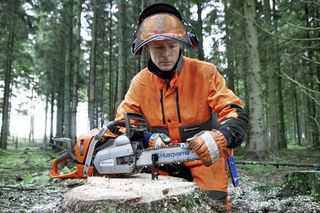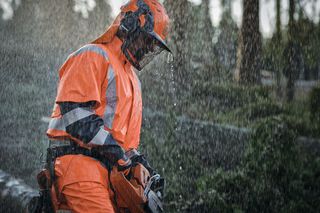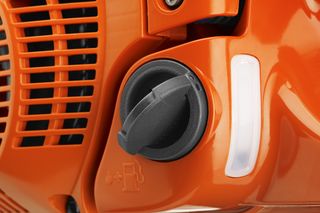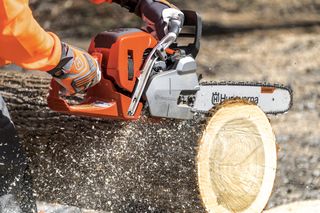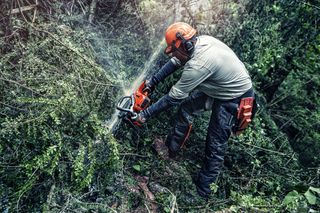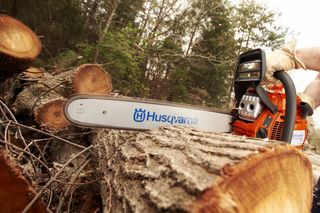
Common Chainsaw Problems Solved
Chainsaws are among the most efficient power tools around. Few others can move a few hundred tonne of wood with minimal effort. From felling trees to chopping firewood and carving, a high-quality all-round chainsaw is an arborist’s best friend. Anyone who is familiar with chainsaws will know that they require regular maintenance to keep them in top condition. Accidentally skip a service here and there, and any chainsaw may start to develop problems. Which is why we’ve put together this helpful guide. From experiencing difficulties with getting the engine to fire to a chainsaw engine that won't rev properly, three basic areas may be responsible. To help you get back to work as soon as possible, we will look at the most common problems and how to fix them.
Engines require these three things to run
From an engine not starting to an engine with poor running performance, there are three basic areas that should be investigated first to eliminate the easy, items. These areas with their basic associated components are:
Fuel - Carburettor, Fuel filter, Fuel mix, Hoses, Primer bulb, Breather
Spark - Spark Plug, Ignition unit, HT & short Lead, Stop Switch, Flywheel
Air - Air filter, Carburettor, Manifold, Muffler, Hoses, Breather
Each of these components needs to be in good working order, in order for the chainsaw to start and run smoothly, as well as deliver the power, efficiency and reliability of a new chainsaw.
10 Basic Checks
- Pull the starter rope to see if the engine turns over and if compression is adequate.
- Check fuel for quality and correct mix – recommend replacing with a known mix.
- Check the fuel filter for blockage.
- Check fuel supply pickup and hose for blockage or cracking from age.
- Check the air filter for blockage.
- Check the carburettor settings are correct (including the idle adjustment).
- Check for spark.
- Check spark plug electrode for wear or carbon build up and correct gap.
- Check the muffler spark arrestor screen, if fitted visually check hoses, manifold and cylinder base gasket for leaks.
- Remove the exhaust to check for piston seizure or ring damage if compression seems inadequate.

Checking Fuel Supply
There are typically three fuel-related checks that you will need to make. These include checking the fuel mix itself, checking for blockages or cracked lines and checking the chainsaws carburettor settings.
Begin by emptying the fuel tank and replacing it with a good quality well-known fuel mix. If your chainsaw has been standing for an extended period of time with fuel in the tank, it may be contaminated. Find out how to mix two-stroke fuel here.
If you discover that the fuel filter is blocked, a fuel system cleaner can help. Fuel system cleaner is added to the fuel tank and left to sit for several hours. You then need to start the chainsaw to distribute the fuel system cleaner evenly throughout the engine. If there are any blockages, this will help remove them.
The fuel filter helps feed fuel into the engine from the fuel tank. It connects to the internal fuel line and prevents wood chips, oil and dirt from contaminating the fuel. The fuel line is connected to the carburettor, which can be found near the throttle at the rear of your chainsaw. Check this fuel line to make sure it isn’t cracked or broken, as they can become brittle with age.
As the fuel filter is connected to the fuel line, you will need to pull out a little of the fuel line to expose it. Take care not to pull too hard. If the fuel filter is damaged or blocked, it can be removed and replaced with a new filter. Simply pull off the old filter, twist on the new one and feed it back into the chainsaw housing.

Checking Air Flow
The air filter on a chainsaw is like the lungs of the tool. In fact, on average, just one minute using a chainsaw will use the same amount of air as the average person breathes in over a six-hour period. When the air filter becomes clogged, the amount of air able to reach the combustion chamber drastically reduces. This can result in poor performance, sputtering and failure to start. Imagine trying to sprint for 60 seconds while holding your breath; it’s not going to be easy.
If the air filter is blocked, then your best bet is to replace it. The air filter on a chainsaw removes airborne contaminants from entering the chainsaw combustion chamber. Using your chainsaws user manual, locate the filter and check it for buildup. You should also check the muffler.
The muffler is used to reduce the amount of noise a power tool produces. Compressed air is a great way to remove any excess carbon deposits once it has been removed from the engine. While checking the muffler, you should also check that the muffler spark arrestor screen, which prevents the muffler from combusting, is also clean and free from debris build-up.
Lastly, check all of the hoses and gaskets to ensure that nothing has worked its way loose.
Checking for Spark
Without a spark, the fuel is unable to ignite, and the chainsaw won’t be able to start up. Luckily, this is one of the easiest things to check on your chainsaw.
To check for a spark. Locate the spark plug on your chainsaw and remove the cover. Remove the spark plug from the cylinder and attach the spark plug wire to it. Do not put the spark plug back into the cylinder. Touch the spark plugs electrode tip to a metal surface on the engine and pull the starter cord. If you can see sparks, then your spark plug is working.
If you do not see a spark, you should then check the spark plug electrode for carbon build-up, damage or wear, and the correct gap spacing. Give the spark plug a good clean with a damp cloth and allow it to dry before testing it again.
If the spark plug produces a spark and you are still having difficulties starting your chainsaw, it's time to check the gap. The spark plug gap is an air gap between the ground electrode and the center electrode. If the gap is too small, the spark struggles to ignite the fuel and air mixture. If the gap is too large, it can make it difficult for the spark to bridge the gap.
Over time, the electrodes wear away due to the constant arcing of sparks. This can lead to the gap becoming larger and might result in difficulties with starting your chainsaw. If the gap looks too large, then replacing the spark plug is a good idea.

Setting a Chainsaw Carburettor
If you are still experiencing problems after trying the above fixes, it's time to look at the carburettor.
Start by placing your chainsaw on a sturdy and even surface. Power up your chainsaw and let it warm up for roughly five minutes or so. Next to the pull rope on the body of the chainsaw you will find three different adjustment screws. Each screw has a letter stamped next to it.
The adjustment screws work by fine tuning the carburettor. Think of them like guitar strings. When they are not set perfectly, the sound and performance will be off. The letters on the screws represent High (H), Low (L) and Idle (T). The H screw regulates the Air/Fuel mix during high RPMs, while the L Screw does the same during low RPMs. The T screw regulates how much fuel is sent to the carburettor while idling until the throttle is pressed.
L Screw - With the chainsaw still running, take a screwdriver and turn the L screw clockwise. Keep turning it until the engine almost stops turning. Next, begin to slowly turn the adjustment screw counterclockwise until you hear the engine idling smoothly. Rev the engine and check for a nice, smooth and responsive rev up. Keep making fine adjustments to the L screw until the engine accelerates smoothly.
T Screw - Next, locate the T screw. This adjustment screw is responsible for adjusting the chainsaws idle. Begin by turning the T screw clockwise until the chainsaw chain begins to move. As soon as you notice it moving, turn the T screw counterclockwise slowly until the chainsaw chain stops. The engine should continue to idle smoothly with the chain not moving around the chain bar.
H Screw - The final step is to adjust the H screw. Screw it counter-clockwise until the screw comes to a natural stop. Do not try to force it beyond this point. You will notice that the engine sounds rough. You then want to begin turning the H screw clockwise until the engine sounds smooth. Give the throttle trigger a little squeeze. Smoke should not be blowing from the exhaust, and the engine should accelerate with ease.

Checking for Compression Problems
If your chainsaw is not starting when you pull the starter rope, and you’ve checked the above, there may be a problem with the compression. A petrol powered chainsaw has several moving parts. To keep these parts moving, a certain amount of compression is needed.
Compression is generated by the engine via the crankcase and the combustion chamber. When compression is too low, you may experience decreased power or complete shutdown because the engine isn’t able to hold enough pressure in the cylinder to run efficiently. A simple way to check for low compression is to place the chainsaw on the ground and use the starter rope to lift it.
Good compression will prevent the rope from pulling out. You should be able to carefully lift the weight of the chainsaw by the starting cord. If you do notice the rope slowly extending, then the chainsaw compression is most likely low and needs checking more precisely.
The most common places for an air leak to occur are on the crankshafts seals. Damage to the piston or the piston rings may also be the cause of the problem.
Piston rings contain cycle pressures, ensuring the force from combustion is spent pushing the piston down on the power stroke. If there is a leak, cycle pressure can leak into the crankcase, resulting in a lack of power or the engine may not start at all.
You should always refer to your owner's manual throughout the process. If you don't feel comfortable repairing your chainsaw yourself. It is a good idea to let the professionals take care of it for you.

